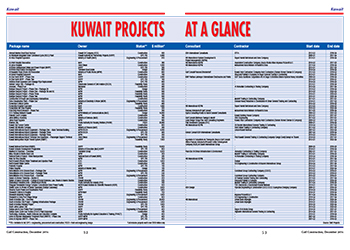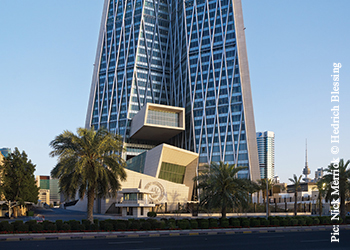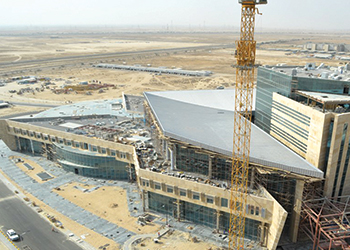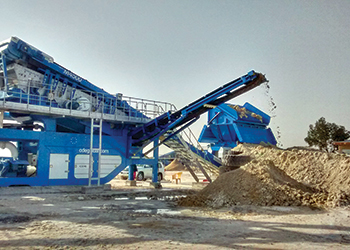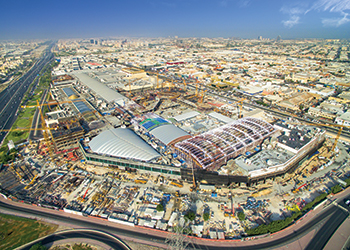
 The Avenues, Phase Four expansion ... an Ahmadiah Contracting and Trading project.
The Avenues, Phase Four expansion ... an Ahmadiah Contracting and Trading project.
In an attempt to offset the drop in oil revenues, Kuwait is turning to the private sector for undertaking projects. The Development Plan 2020 sees $116 billion to be spent on large-scale infrastructure projects.
A dynamic development plan that involves an outlay of $116 billion on infrastructure projects until 2020, the government’s desire to propel growth through initiatives such as public-private partnerships, and new investment regulations provide the right ingredients for Kuwait’s success over the long term.
The country’s 2015-2020 plan envisages the $116-billion spend on large-scale infrastructure projects in an attempt to push ahead with its goal of transforming the country into a regional trade and financial hub by 2035 while reducing its reliance on oil, which currently accounts for more than 90 per cent of its revenues. Oil revenues have nosedived by 60 per cent over the past two years and Kuwait posted its first budget deficit of $15 billion last year after 16 years of surpluses.
To realise its development plan, the state will need to increasingly leverage the resources of the private sector. Foreign investment will also be required to complete ambitious projects such as the $132-billion plan to develop five islands. Feasibility studies currently under way on the islands will be completed next year to enable its completion by 2030.
The Development Plan 2020 is a driver for future growth in the construction sector even though there is uncertainty surrounding the Kuwait economy because of the elections (November 26) and low oil prices, according to Tariq Shuaib, managing partner at design practice Pace (see Page 54).
The persistent low oil prices, the protracted decision-making processes and the political instability of the region continue to slow down the implementation of the country’s ambitious growth plans.
According to a report by National Bank of Kuwait (NBK), the total value of Kuwait’s projects market (active and planned) stood at KD75.1 billion ($247 billion) by the end of September, up 0.8 per cent year-to-date. Citing data from Meed Projects, NBK states that the total value of contracts awarded this year is expected to reach $19.7 billion, and forecasts this will double in 2017 to $38.1 billion.
The Business Monitor International (BMI) anticipates better things to come for Kuwait: it has raised its outlook for growth in the country’s construction sector, predicting a 4.6 per cent growth in 2016 and 2017 – envisaging sustained government support for infrastructure projects and a strengthening project pipeline.
According to BMI, Kuwait is well placed to weather a protracted period of low oil prices, as its sovereign wealth fund contains reserves of more than $592 billion. It points out, however, that despite sustained government support for infrastructure projects and increasing private investment inflows, Kuwait’s construction sector growth rates will continue to trail those of neighbouring GCC markets.
In its Q4 2016 Kuwait Infrastructure Report, BMI says Kuwait will post moderate, if unspectacular, construction sector growth in 2016 and 2017, as the government ramps up public expenditure for infrastructure projects in support of economic diversification. Although streamlined PPP (public-private partnership) legislation has catalysed an uptick in PPP activity, Kuwait’s cumbersome business environment as a whole remains unattractive to private investors, which will weigh on growth potential in the coming years.
Kuwait has 17 PPP projects with a cumulative value of $25 billion currently moving through the pipeline. These projects are being spearheaded by the Kuwait Authority for Partnership Projects (KAPP, previously Partnerships Technical Bureau) through PPPs, which is expected to emerge as an increasingly vital tool in bridging the funding gap.
Among the key areas of growth over the next few years will be affordable housing as Kuwait addresses its housing shortage. Major initiatives in this direction was the award of a $955-million contract by the Public Authority for Housing Welfare (PAHW) for a 120-sq-km urban residential development project and a deal with the Korean government to build a smart housing development.
Other key areas of investment are expected to be transportation including the expansion of its airport, new ports and expansion of existing ones, and the $20-billion metro and rail; power, water and sewerage schemes; and social infrastructure such as hospitals and schools. Also, up to $35 billion could be invested in oil and gas over the next five years.
A foreign direct investment law – the Direct Investment Promotion Law – aimed at improving Kuwait’s business environment and removing obstacles to entry should underpin private investment growth. The law is expected to address fundamental flaws in the system and reduce red tape, paving the way for large companies to be formed quickly.
Airports & Ports
Among the much-delayed major projects that was finally flagged off was the new passenger terminal at Kuwait International Airport. Turkey-based Limak Construction and the Kuwaiti firm Kharafi National signed a $4.3-billion contract to build the 708,000-sq-m terminal that will have capacity to handle 25 million passengers annually – triple the airport’s current capacity of eight million. The government also allocated land for Jazeera Airways’ additional dedicated passenger terminal and car-park buildings at the airport to be built at a cost of $46.2 million.
Meanwhile, the Amiri Dewan has recently awarded a contract for the Kuwait Airport expansion passenger support building project, according to the NBK. Valued at $174 million, the project will serve as a back-up for the current facility until the new terminal is completed. It is expected to accommodate about 4.5 million passengers a year and all the departure and arrivals facilities as well as a 1,600-slot car-park.
Work is also in progress on the first phase of the $16-billion Mubarak Al Khabir, as part of plans to transform Bubiyan island – Kuwait’s largest – into a commercial seaport.
Roads
Kuwait has plans to invest about $6.2 billion on its road projects which would stretch across 550 km. According to the NBK, projects worth KD572 million ($1.9 billion) were awarded in the third quarter of this year. Some of the major projects include the development of the Northern Regional Road, the 6.5-km-long Ring Road and the improvement of the Sheikh Jaber Al Ahmed Al Sabah Road.
Among the major projects under way is the estimated $3-billion Subiya Causeway – also known as Sheikh Jaber Al-Ahmed Al-Sabah bridge – being built under a PPP scheme. The 37.5-km bridge, which will cross Kuwait Bay, linking Kuwait City, the Subiya peninsula and Bubiyan Island, is being built under a design-and-build contract by Kuwait’s Combined Group Contracting and Hyundai Engineering & Construction. The project is expected to be completed in 2018. Work is also in progress on the 13-km Doha link which forms part of the project.
Another major development is the Jahra Road project, one of the largest elevated road projects in the world. The project, which is close to completion, has entailed the construction of 17.7 km of viaducts, 0.62 km of depressed road, two roundabout bridges and 10 pedestrian bridges.
Railways
The $7-billion Kuwait Metropolitan Rapid Transit System (KMRT) project is yet to make any progress, although financial allocations have been made for the ambitious metro project. The 160-km project is expected to be implemented as a PPP scheme.
Another PPP project in this sector that is yet to move ahead is the 574-km Kuwait National Rail Road (KNRR) that will link to the 2,117-km Gulf railway network, the completion date of which has been further delayed to 2021. According to a Kuwait Times report, the KAPP is scheduled to tender the $10 billion project during the first half of 2017.
Power & Water
Kuwait is expected to spend $10 billion to boost its power generation capacity by 3,580 MW. As part of these plans, the second phase of the Al Zour North power and water project has received the go-ahead as an independent power project (IPP). Other projects include first phase of the oil- and gas-fired Khairan power plant, and the 280 MW Al Abdaliyah integrated solar combined-cycle PPP power project – which will produce 60 MW of its output from solar energy.
The Khairan plant, which is also being pursued as an IPP, will include a conventional thermal steam power plant with a capacity of 1,800 MW and a sea water desalination plant with a capacity of 125 million gallons per day. KAPP is expected to issue tenders to build the plant by the end of the year.
Contracts worth some $7.1 billion are expected in the medium term to be awarded by the KAPP in this sector.
Housing & Real Estate
According to BMI’s Infrastructure Report, Kuwait’s residential market will see increased spending over the next five years, as the government attempts to address the country’s persistent housing shortfall. The nation’s housing deficit is expected to widen to 175,000 units by 2020, up from 110,000 at the end of 2015, it adds.
The PAHW – which has 26 housing projects under way at a cost of KD683 million ($2.25 billion) – aims address this deficit by inviting private developers on a number of projects, including the Mutlaa Residential Project, Al Subiya Residential City and Sabah Al Ahmad Township. The government has joined hands with South Korea to develop the $4-billion South Saad Al Abdullah New City, a smart city which will cover 59 sq km in the west of the country and will comprise 25,000 residential units.
Among the mega housing developments under way is the South Al Mutlaa City, being developed on a 104-sq-km site west of Kuwait City, to house a population of 400,000 when complete. Italian industrial group Salini Impregilo in joint venture with Turkey’s Limak Construction has secured the $955-million contract to build it.
The Sabah Al Ahmed Sea City, an ambitious project being developed in the south of the country, will eventually house 250,000 people. Named after the emir of Kuwait, the project has transformed a giant salt marsh with much of its infrastructure already built. Using tidal gates, the sea has been brought almost 9 km inland from the Arabian Gulf.
Meanwhile, Tamdeen Group has launched a $700-million mixed-use development called Al-Khiran within the project, which will include a 900-boat marina, a five-star hotel, a services apartments, two residential towers and a mall.
Another big-ticket project is being spearheaded by Kuwait Projects Company (Kipco), which intends to spend $5 billion in developing a 380,000-sq-m mixed-use scheme in Al Da’iya on the outskirts of Kuwait City.
Kipco has awarded a contract to Ahmadiah Contracting & Trading Company for the Hessah Al Mubarak which will comprise 82 residential and commercial plots as well as infrastructure such as roads, parks and walkways. Through its subsidiaries, Kipco will be developing 38 plots of the development scheme, while the rest will be developed by other parties, says the NBK. Residential properties in the first phase are scheduled for handover by 2020.
In the retail sector, Kuwait’s showpiece mall The Avenues is in the midst of its fourth phase expansion which is being implemented by its developer Mabanee at a cost of $910 million. The contractor on the project is Ahmadiah Contracting and Trading, which is expected to complete it by 2018.
Tamdeen Group has also begun a major expansion of its 360 Mall, which will include additional retail space, multipurpose indoor sports and entertainment facilities including Sheikh Jaber Al Abdullah Al Jaber Al Sabah International Tennis Complex, a five-star hotel and a health club. The project is expected to see completion by 2019.
Oil and Gas
Among the largest infrastructure projects under way in Kuwait is the $16-billion Al Zour Refinery project, which upon completion in 2019 will become Kuwait’s fourth oil refinery.
Also, Kuwait National Petroleum Corporation has awarded a $2.9-billion deal to a consortium led by Hyundai Engineering for the construction of the country’s largest liquefied natural gas (LNG) import facility at the Al Zour refinery. The project is scheduled to be completed in 2020.
AT A GLANCE
2015-2020 Development Plan: $116bn
Current PPPs: 17, worth $25 bn
New airport terminal: $4.3bn
Roads: $6.2bn
Power: $10bn
Oil & Gas: $35bn
Budget deficit: $15bn
PAHW – 26 housing projects: $2.25bn
YET TO TAKE OFF
Rapid Transit System: $7bn
Kuwait National Rail Road: $10bn





















_0001.jpg)


.jpg)
















.jpg)








.jpg)



